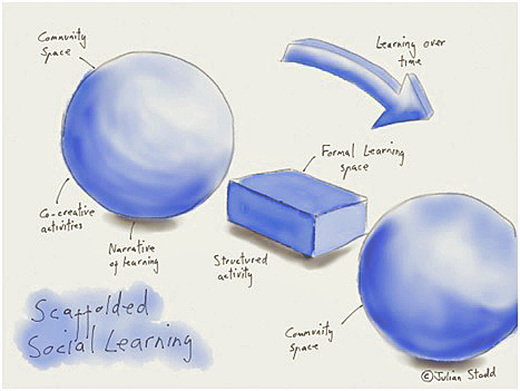
balance the structure and defined outcomes of formal instructionally oriented learning with the collaborative, co-creative and 'sense making' functions of social contexts for learning in the manner depicted below.
Scaffolded social learning is built around two types of components: formal elements of learning shown as 'boxes' in which the learning is pre-planned and 'bubbles' of social activity in which learning is informal and emergent. At the boundary between each, there is a gateway.
The boxes embody experiences that are formally defined learning: maybe eLearning, classroom or open educational resources. The narrative in these spaces is defined by the designers and teachers who own the space. The bubbles are co-creative, community spaces, places where we can feed out questions, case studies, activities and exercises that are carried out over time and within communities or more participatory collectives(2). Here the narrative is created by the learner and co-created by the other active participants in the social space.
In scaffolded social learning the overall arrangement is defined by an overarching narrative developed and maintained by one or more social leaders who act as brokers and guides. They identify the need or interest and create the purpose, visualise and maintain the structure and facilitate the process through which learning emerges. They are the creators of the ecology for collaborative learning - another important concept in social learning (3).
I connected Julian's concept of scaffolded social learning to Jane Hart's idea of 'learning flows' (3). Jane argues that 'in the age of Facebook and Twitter, and Enterprise Social Networks (ESNs) like Yammer and Jive (where at the heart lies an activity stream that is used for a continuous stream of knowledge exchange) – there is a place for a new learning framework; one that lies between the instructionally designed course and the unstructured knowledge sharing of teams, groups and communities. We call this a Learning Flow.'
A Learning Flow is a continuous steady stream of social micro-learning activities – accessible from the web and mobile devices. Its properties are:
· continuous – ongoing (ie no end date)
· steady – eg daily or weekly
· micro-learning – short – ie taking no longer than 15-20 minutes to undertake
· involve activity – like reading, watching or listening to something and doing something
· social – that invite and encourage active participation and contribution
· streams – that are organised and structured in the Flow in weekly themes
· accessible from web and mobile devices – to ensure that learning can take place anywhere and at
anytime
For individuals, being present in a Learning Flow means having some help to navigate the turbulent waters of a fast flowing constant stream of (new) information and knowledge, retaining control over how and when they get involved, and how they fit it into their daily workload – autonomy is a key element of participation.
Learning Flows are suitable for:
- Enterprise use – to provide ongoing updating of teams or groups
- Educational use – to provide an extra dimension to academic subjects – probably alongside a
formal curriculum
- Professional use - for generic topics of interest in areas like Marketing, Leadership, L&D, etc, where it is vital to keep up with new knowledge and practices.
- Personal development use - topics of interest that are not directly related to work but are relevant to leading a more fulfilled and meaningful life and indirectly might enhance professional performance can be
Jane describes three types of Learning Flow to encourage short social learning experiences.
(1) NEWS FLOW provides a daily social-micro learning activity based on current news and resources from the Social Web. This is a useful way of encouraging a group of people to reflect on and discuss up-to-the-minute news. This type of Learning Flow is closest to the unstructured learning that takes place in activity streams, but it has the advantage that the participants are only subjected to one piece of news daily - so that the “signal has been separated from the noise” by the Learning Flow Guide.
(2) THEMED FLOW provides daily social micro-learning activities organized within weekly themes around a specific topic. This is a useful way for bringing together related activities in some logical sequence during the week, so that the Learning Guide can help the participants to “join the dots” between new ideas and resources.
(3) CIRCULAR FLOW is a rotating flow of a set of weekly themes (although activities within them may change). This Learning Flow is closest to the traditional course since it deals with a well defined body of knowledge, but it differs from a course in that content is used to support the social learning experience – rather than social interaction being added to content (as happens in many courses) there is a Guide rather than an Instructor, and there is more autonomy and choice for the user
It seems right that these ideas of scaffolded social learning and learning flows should be connected and integrated. What do you think?
Sources of ideas
1) Julian Stodd Scaffolded Social Learning posted 5 November 2014 http://julianstodd.wordpress.com/2014/11/05/scaffolded-social-learning/
2) Douglas Thomas and John Seeley Brown A New Culture of Learning: Cultivating the imagination for a world of constant change
3) Norman Jackson 'The Concept of Learning Ecologies' in N. J. Jackson and G.B. Cooper (eds) Lifewide Learning, Education and Personal Development e-book Chapter A5 available on-line at http://www.lifewideebook.co.uk/conceptual.html
4) Jane Hart 'Beyond the Course: The Learning Flow – a new framework for the social learning era' posted 19 February 2014, http://www.c4lpt.co.uk/blog/2014/02/19/the-learning-flow/
5) Jane Hart 'Three Types of Learning Flow' posted 25 February 2014
http://www.c4lpt.co.uk/blog/2014/02/25/types-of-learning-flow/
 RSS Feed
RSS Feed
